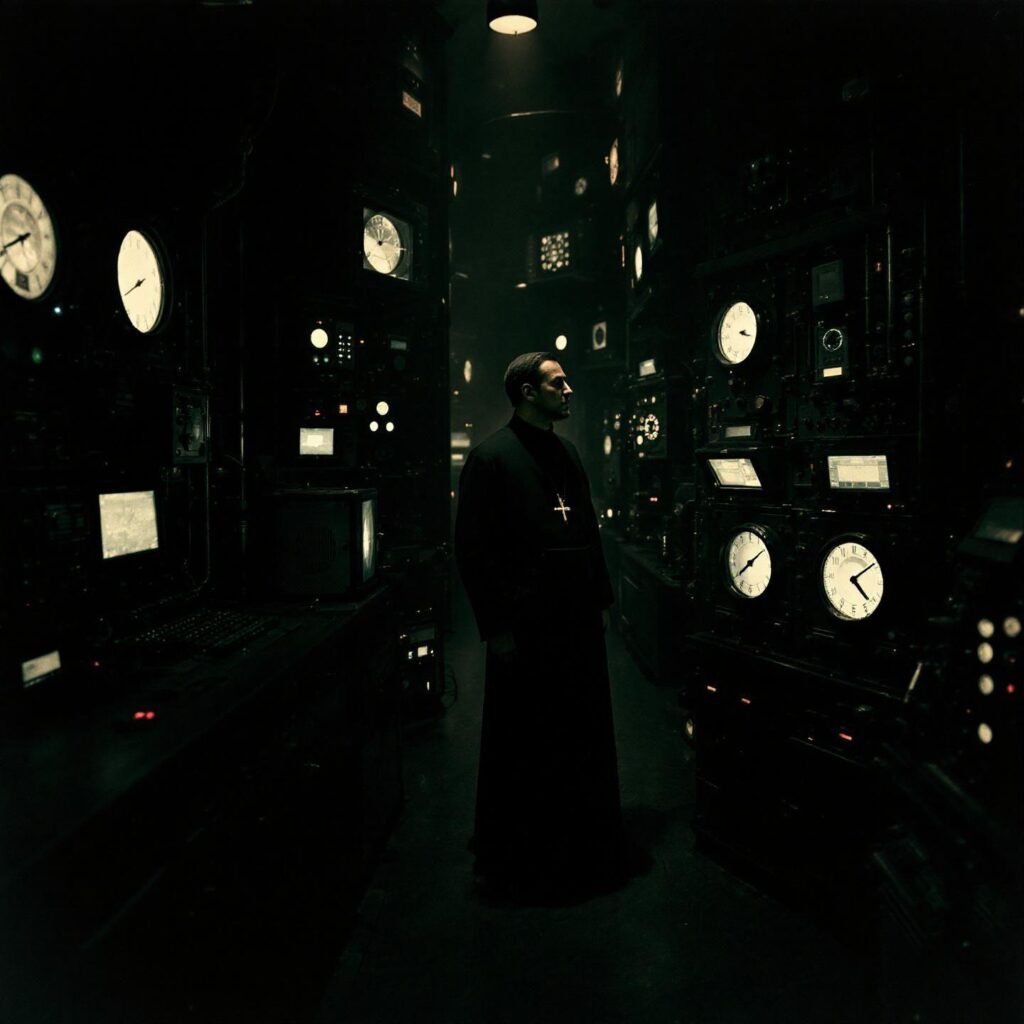Among all the strange mysteries surrounding religion, technology, and hidden Vatican secrets, none are more shocking than the legend of the Chronovisor Photos—and more specifically, the so-called image of Jesus Christ at the moment of his crucifixion.
It is claimed that this image was obtained through a mysterious device. This device supposedly permitted viewing of the past, called the Chronovisor, and was developed by scientists and priests, according to the Vatican.
At first sight, this sounds like science fiction. Yet the devotees of the Chronovisor story maintain it is based on fact.
Is it an elaborate joke? A miracle? Or, a truth too dangerous for the world to view?
Here we will explore the origins, technology and controversy surrounding one of the most absurd conspiracy theories of contemporary religious history.
Contents
- 1 Who Was Father Pellegrino Ernetti?
- 2 What Was the Chronovisor Device?
- 3 The Chronovisor Photos of Jesus: Fact or Forgery?
- 4 Was Chronovisor Technology Scientifically Possible?
- 5 The Vatican’s Role in Suppressing Chronovisor Photos
- 6 Why People Still Believe in Chronovisor Photos
- 7 A Mystery That Refuses to Die
Who Was Father Pellegrino Ernetti?

The legend of the Chronovisor starts with Father Pellegrino Maria Ernetti, who was born in Italy in 1925.
Though he was indeed an unusual character, he was actually a Benedictine monk, a theologian, and one of the most studied scholars of ancient music.
He was also affiliated with the Vatican and was particularly knowledgeable about Gregorian chants and early Christian texts.
Additionally, he had also been imaginably involved in exorcisms and test drove some physics. It was a combination of religious seriousness and scientific intrigue.
In the 1950s and 60s, Ernetti claimed to be part of a secret group of scientists and clergy who created a remarkable device:
The Chronovisor — a machine that could station in the past and show it like a movie on the screen.
Some of the supposed contributors included such esteemed individuals as the physicist Enrico Fermi and the aerospace engineer Wernher von Braun.
Ernetti claimed he and the group were successful — and that he had seen history reenacted before his own eyes.
What Was the Chronovisor Device?

Ernetti explained that the Chronovisor was not a traditional time machine. It could not take you back to any given time or place.
It was a “time viewer” — a machine which received the energy residues of the past still reverberating through space.
He said the machine had input arrays of antennas and sensors to read and calculate the electromagnetics and sound waves related to historic moments — their echoing signature.
Energy waves were picked up, modified and displayed on a screen. The viewer was watching real events of historic importance as if they were alive.
Like CBS anchorman Walter Cronkite was, if he were recounting memorable events from 200 years ago.
Ernetti said he had watched historic or notable events using the Chronovisor, including:
- A performance of the ancient Roman tragedy Thyestes by Quintus Ennius. The work would later become unheard, a significant play in history.
- The speeches of decriers Napoleon Bonaparte and Marcus Tullius Cicero — oratory greats of world history.
- And most remarkably — the crucifixion of Jesus of Nazareth.
Ernetti did not just say he viewed these events — he said he had photographic proof.
The Chronovisor Photos of Jesus: Fact or Forgery?

The most notorious claim involving the Chronovisor photo is that it captured Jesus Christ on the cross during the crucifixion.
Ernetti claimed the device recorded a moment in the crucifixion — a black and white photo showing Jesus’ agony, his head drooped forward, wearing a crown of thorns as he hung from the cross.
This photo was later published in an Italian magazine in 1972 and created a stir of excitement. To many believers, it seemed like God’s confirmation — a scientific image of the most holy experience in Christianity.
But researchers were quick to note the problems involved with it.
The image seemed nearly identical to a well-known postcard of a sculpture that sat at an Italian church. It was a reverse version of the religious statue.
This was not a real-time historical recording. Just to note — the similarities were astounding.
This revelation led many to put the Chronovisor photos in the basket of hoax images. They were perhaps staged or modified to substantiate Ernetti’s statements.
Was Chronovisor Technology Scientifically Possible?
From a science viewpoint, the Chronovisor seems to have been considered pseudo-science.
Not one piece of evidence of the device has been able to turn up. There are no diagrams, no technical specifications, and no parts.
Ernetti described the Chronovisor as composed of:
- Three varieties of antennas
- A display device for viewing the image
- A device for tuning into specific places and times
- A synchronizing device to extract and record audio-visual images
He insisted it stole energy from the past. That the energy that remains from an event exists as some sort of electromagnetic radiation and sound frequencies.
However, current science has nothing like it. Events do not leave permanent traces that we can “play back” — at least not as we currently understand the laws of physics.
The entire idea goes against everything we know about thermodynamics, quantum mechanics, and the arrow of time.
Like other mythic relics like the Iron Maiden torture device, the Chronovisor probably amounts to more legend than reality—a gadget that became famous through folklore and mass media and not real history.
In conclusion, the technology may sound believable to a casual listener. But from a science-based point of view, it quickly falls apart.
The Vatican’s Role in Suppressing Chronovisor Photos
There are numerous enigmatic components of this saga. Perhaps none more compelling than the alleged Vatican connection.
Ernetti said the Vatican not only knew about the Chronovisor but that it ordered it removed and hidden. This was to prevent it from falling into the wrong hands.
Ernetti believed that if the Chronovisor could be used for non-scientific or dire purposes, it could easily alter political, religious or economic power structures. It could allow people to observe events differently than conventional or accepted historical records.
There were moral implications as well. Is it really accepted that anyone has the right to see any moment in time — even highly personal or tragic events?
Father François Brune, a Catholic priest and author, supported Ernetti’s claims. He said that he saw the Chronovisor photo and believed it to be real.
Brune later wrote that the Vatican had stored the machine in a vault and kept it away from public view.
The Vatican, for its part, has never said anything formally about the Chronovisor. That silence adds to decades of speculation and conspiracy theories.
Why People Still Believe in Chronovisor Photos
Though there’s no evidence for the existence of the Chronovisor or the authentic photo of Jesus, belief in the Chronovisor continues. Why?
It may be partly psychological.
The concept of viewing the past is fascinating. Especially for the faithful who want material confirmation of an event in their holy book.
Other people are mostly fascinated with its mystery. A secret machine that is buried in the Vatican that could show the world the greatest events of history.
It is also part of our ongoing cultural obsession with suppressed technology and hidden truths. From Dan Brown novels to ancient aliens to secret inventions, people believe powerful institutions keep things from us.
There is an emotional resonance with the idea that the truth is suppressed.
The Chronovisor continues to reappear in documentaries, conspiracy websites, Reddit threads, and YouTube videos. It is often discussed along with other alleged Vatican secrets.
A Mystery That Refuses to Die
So, what might we take away from the Chronovisor Jesus photos?
The photo is almost undoubtedly a 100% fake. The scientific evidence to support the Chronovisor is extremely weak.
There is no verifiable physical evidence that would document the Chronovisor was real.
Yet the narrative endures — perhaps because it speaks to something greater than science or faith.
Whether it is a hoax, a spiritual metaphor, or an initiation into something more nefarious occurring at the Vatican, the Chronovisor embodies one of the most fascinating intersections of religion, technology, and conspiracy.
The photo is debunked, but the folklore lives on!
